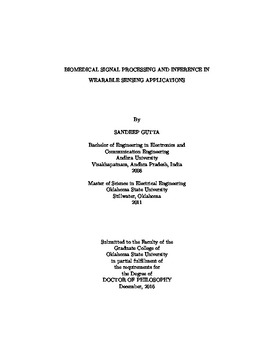| dc.contributor.advisor | Cheng, Qi | |
| dc.contributor.author | Gutta, Sandeep | |
| dc.date.accessioned | 2018-06-25T13:38:21Z | |
| dc.date.available | 2018-06-25T13:38:21Z | |
| dc.date.issued | 2016-12 | |
| dc.identifier.uri | https://hdl.handle.net/11244/300241 | |
| dc.description.abstract | With the increase in health care costs, there is a great need to develop a low-cost and efficient health care system with better accessibility. Recent advances in the fields of embedded sensing, mobile computing, and wireless communication have led to the development of several low-cost wearable health sensors that can noninvasively collect different physiological signals such as electrocardiogram (ECG), peripheral oxygen saturation (SpO2), blood pressure, airflow, etc. With the availability of these wearable sensors and powerful smartphones, it is now possible to build a smart health monitoring system that can continuously monitor and track a person's health without the need of a hospital visit. In this research, we primarily focus on the signal processing and statistical inference aspects of the smart health system. First, we develop a biometric recognition system using the ECG signal, which is easily measured by several wearable devices. A multitask learning framework, in which the feature selection and classifier design are combined, is proposed to improve the overall learning efficiency. Experimental results on real ECG data show the effectiveness of the proposed method over other approaches. In the next part, we focus on the mathematical modeling of the local control mechanism of the cardiorespiratory system. We use a nonlinear model of the cardiorespiratory system with heart rate and ventilation rate as the control signals. An iterative algorithm is proposed to calculate the optimal control signals. In the final part, we focus on the detection of a chronic respiratory sleep disorder, sleep apnea, using measurement signals from wearable sensors. A new framework combining multiple sensor measurement data with the cardiorespiratory system model information is proposed. Experimental results on both synthetic and real data show the effectiveness of the proposed framework. Comparisons with purely data-driven apnea detection methods demonstrate the advantage of combining the sensor measurement data with cardiorespiratory model information. | |
| dc.format | application/pdf | |
| dc.language | en_US | |
| dc.rights | Copyright is held by the author who has granted the Oklahoma State University Library the non-exclusive right to share this material in its institutional repository. Contact Digital Library Services at lib-dls@okstate.edu or 405-744-9161 for the permission policy on the use, reproduction or distribution of this material. | |
| dc.title | Biomedical signal processing and inference in wearable sensing applications | |
| dc.contributor.committeeMember | Sheng, Weihua | |
| dc.contributor.committeeMember | Fan, Guoliang | |
| dc.contributor.committeeMember | Benjamin, Bruce A. | |
| osu.filename | Gutta_okstate_0664D_14976.pdf | |
| osu.accesstype | Open Access | |
| dc.type.genre | Dissertation | |
| dc.type.material | Text | |
| thesis.degree.discipline | Electrical Engineering | |
| thesis.degree.grantor | Oklahoma State University | |
